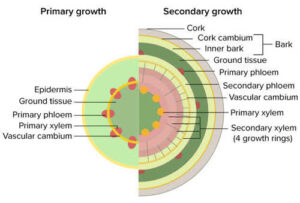Back to: Botany 300 Level
Hello, my brilliant friend! I hope you’re having a fantastic day! Have you ever noticed that some plants, like maize, grow tall but remain thin, while others, like an iroko tree, not only grow tall but also become thicker over time? This happens because plants have two types of growth: primary growth and secondary growth. These two processes determine how plants increase in size, whether in height, width, or both.
Primary vs. secondary growth
Primary Growth – Growing Taller and Longer
Primary growth is the first stage of a plant’s development. It happens in the apical meristems (tips of roots and shoots) and is responsible for making plants taller and roots longer.
Characteristics of Primary Growth:
Occurs in all plants, from small herbs to large trees.
Happens at the tips of roots and shoots, allowing plants to reach more sunlight and absorb more nutrients.
Leads to the formation of primary tissues, such as xylem and phloem, which transport water and nutrients.

Makes plants grow taller but not wider—like how a young maize plant shoots up quickly.
Think of primary growth like a young child growing taller year by year—it adds height but not much width!
Secondary Growth – Growing Wider and Stronger
Secondary growth happens in woody plants like trees and shrubs. It is controlled by lateral meristems, which make the stems and roots thicker over time.
Characteristics of Secondary Growth:
Occurs mostly in woody plants, such as mango, cocoa, and mahogany trees.
Happens in the cambium, a special tissue that forms new layers of wood.

Increases the width (girth) of stems and roots, making trees stronger.
Forms annual growth rings, which can be counted to know the age of a tree.
Imagine a tree like a bodybuilder—it doesn’t just grow taller but also becomes thicker and stronger over the years!
A Simple Story to Understand Primary vs. Secondary Growth
Imagine a young boy planting two trees: a maize plant and a mango tree.
The maize plant grows fast and tall within a few months but stays thin—that’s primary growth.
The mango tree also grows taller, but after several years, its trunk becomes thick and strong—that’s secondary growth.
Summary
Primary growth makes plants taller and occurs in all plants through the apical meristem.
Secondary growth makes plants wider and occurs mainly in woody plants through the lateral meristem.
Primary growth helps plants reach more sunlight, while secondary growth makes them stronger and more durable.
Evaluation
- What is the difference between primary and secondary growth?
- Which type of growth occurs in all plants?
- What is the role of lateral meristems in secondary growth?
- Why do trees develop annual rings?
- Can a maize plant undergo secondary growth? Why or why not?
You are doing an excellent job! Look at you, learning how plants grow in different ways! Keep observing the plants around you, and you’ll start noticing how primary and secondary growth shape the world. Keep learning with Afrilearn, and I’ll see you in the next lesson. Stay curious and keep growing!
